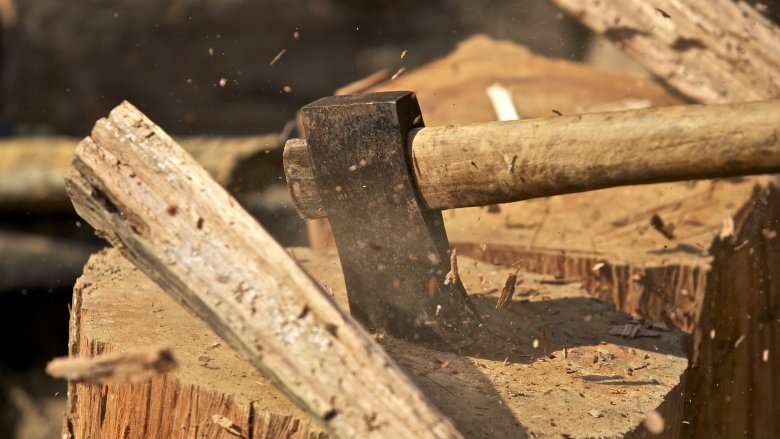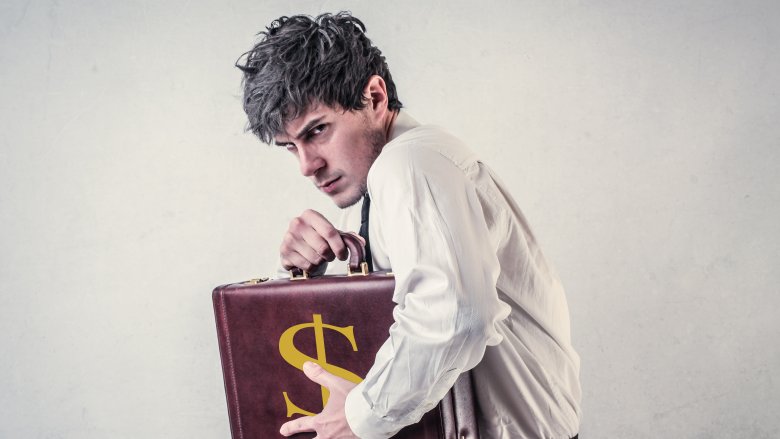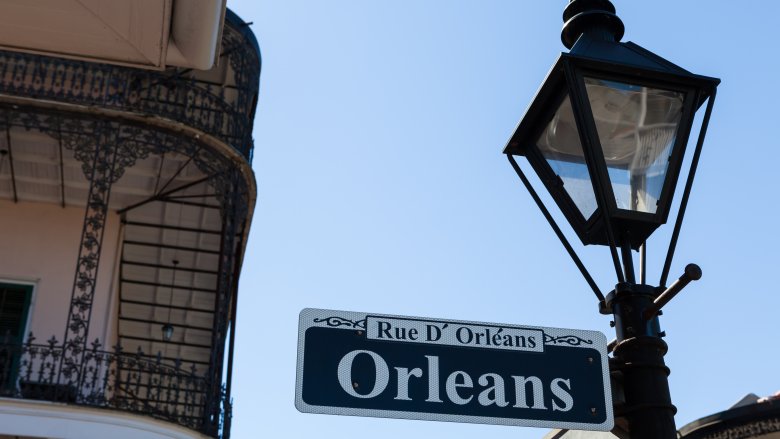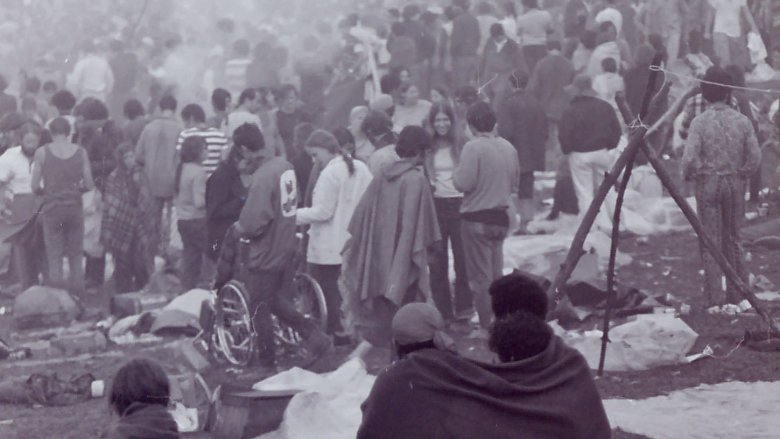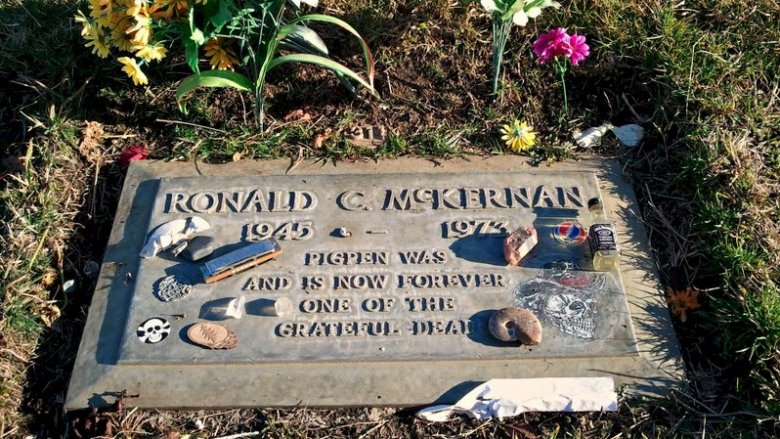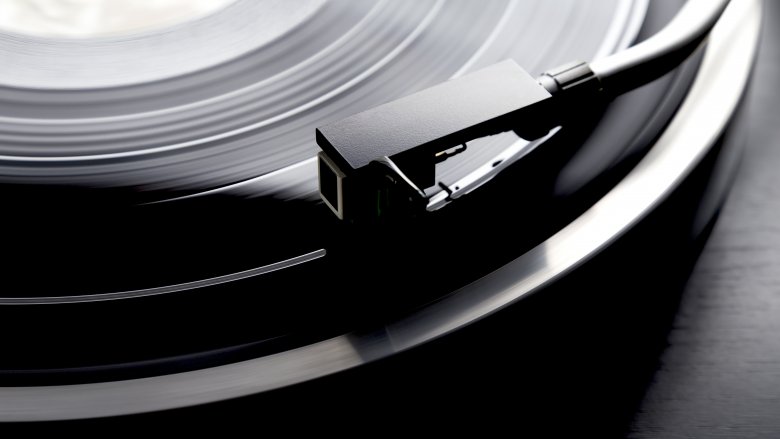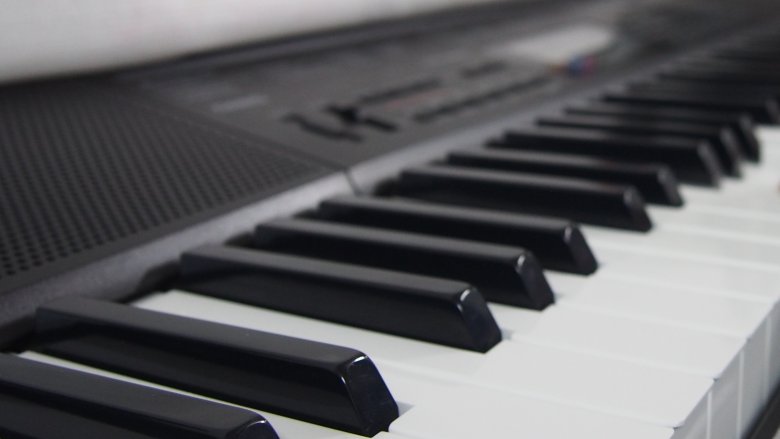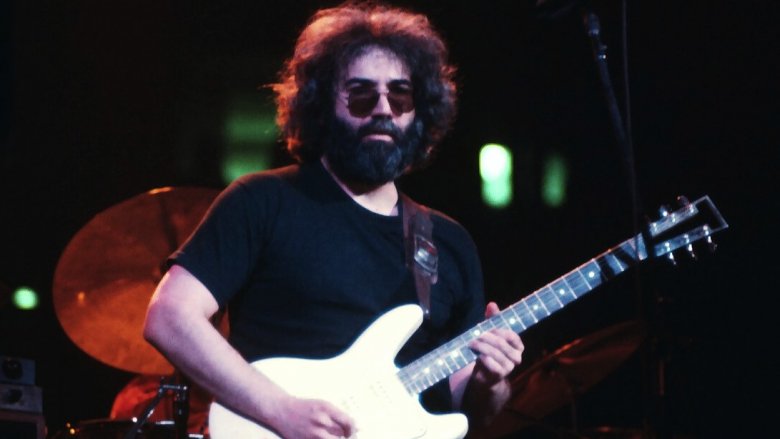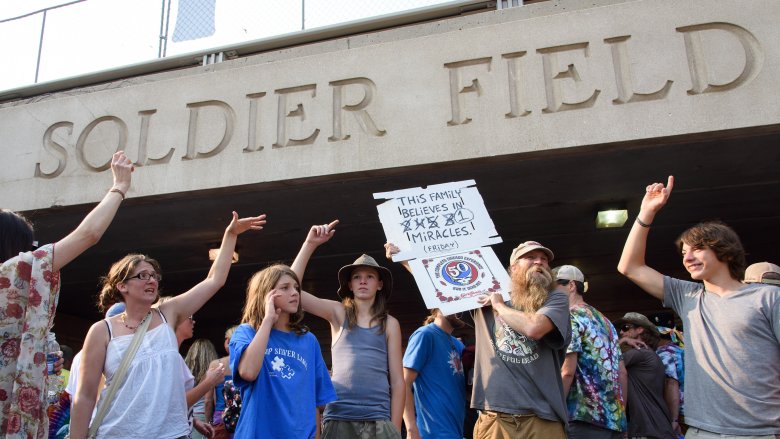The Grateful Dead's Tragic Real-Life Story
The Grateful Dead was one of the most popular jam bands of the late 20th century. While they never quite reached the stratospheric levels of fame of other insanely popular rock acts like the Rolling Stones, it never really mattered.
Their devoted legions of "Deadhead" fans kept them on the road for decades, and countless T-shirts, stickers, posters, and other ephemera made the band widely successful from a financial standpoint. The band's iconic lightning bolt skull logo and multicolored dancing bears have forever entrenched themselves in rock history and countless dorm room walls. The Grateful Dead has even spawned Funko dolls, onesies, and "Cherry Garcia" — Ben & Jerry's ice cream tribute to the band's late, great frontman Jerry Garcia that's become one of its most popular flavors.
But the Grateful Dead's transformation from Mother McCree's Uptown Jug Champions, a fairly obscure band based in Palo Alto, California, in the early '60s, to one of the most beloved touring acts in the world was definitely a "long, strange trip." It was also one beset by a series of unfortunate incidents, controversies, and the tragic deaths of several of its key members.
Jerry Garcia had a difficult childhood
The Grateful Dead's music has often been described as "mellow," but front man Jerry Garcia's earlier years were the exact opposite. During a family vacation when Garcia was 5 years old, he decided to help his older brother chop wood. He was steadying a piece of wood when the ax severed a large chunk of the middle finger on his right hand.
Years later, though, the injury allegedly improved his ability to play the guitar and he often showed off the damaged digit to his fans as a sort of salute. A fan also tried to sell the alleged finger on Craigslist to attend a 2015 reunion show, but it was quickly ruled a hoax by Ultimate Classic Rock (and everyone else who came across it, no doubt).
The same year Jerry lost his finger, his father tragically drowned during a fishing trip, and he and his brother were eventually sent to live with their maternal grandparents for five years. Eager to see the world, he decided to enlist in the Army at the age of 17 in April 1960. It didn't pan out. Garcia made it all the way through basic training at Fort Ord in California, but he was given the boot that December. According to his official website, it was due to his "lack of suitability to the military lifestyle."
One of the band's managers was a holy man who stole from them
Like many other rock bands, managers caused the Grateful Dead plenty of headaches over the years. Lenny Hart was arguably the most aggravating of them all. His son Mickey played in the band in the late '60s, eventually becoming their longtime percussionist.
By all accounts, Lenny Hart was a weird guy. He had a side gig as a preacher and often insisted that people call him "reverend." He also served as the Dead's manager, which wound up being a mistake. According to Rolling Stone, Hart filled the role for around a year and a half between 1968 and 1969. During that time, he embezzled something like $150,000 and hid it in a series of bank accounts and shell companies scattered across California. Then he disappeared with all the cash during a trip to Los Angeles with Garcia.
A warrant was put out for Hart's arrest, and the law finally caught up with him in 1971. According to a Rolling Stone clipping from the Grateful Dead's official archives, he was found "baptizing Jesus freaks" in San Diego. They managed to get back $63,000 of the lost cash, and Hart died of natural causes in 1975. The incident also inspired "He's Gone," a tune about the not-so good reverend's wicked ways.
Busted down in New Orleans ... and a few other places
The Grateful Dead had a fair number of run-ins with the law back in the '60s and '70s. They lived in a boarding house in San Francisco's Haight-Ashbury district during the fabled Summer of Love in 1967, as drummer Bill Kreutzmann recalled in a 2015 article for the San Francisco Chronicle. That era in the band's history was riddled with countless incidents, both delightful and madcapped. Merry Prankster Ken Kesey had to crash his psychedelic bus after the brakes gave out. Faced with the choice to crash into the Grateful Dead's house and a Hells Angels house, he chose the Hells Angels as his landing pad.
Guitarist Bob Weir landed in hot water with the police for tossing water balloons off the roof, but things took an uglier turn when the house was raided that October. Local narcotic officers found a pound of marijuana and hash inside. The incident landed on the cover of The Chronicle and both Weir and founding member Ron "Pigpen" McKernan were arrested.
A few years later, the band ran into trouble in New Orleans during a drug raid that, according to Ultimate Classic Rock, didn't really surprise anyone. Garcia received a tip that the police were en route. Nineteen members of the band's touring party were arrested and the incident was immortalized in the song "Truckin'." Garcia was nabbed again for drug possession during a traffic stop in New Jersey in 1973.
By the time they got to Woodstock, they were pretty far gone
The 1969 Woodstock festival is known for a series of iconic performances that have stood the test of time. The Grateful Dead's set wasn't one of them. One of the reasons is the band was incredibly high by the time they took the stage. But their love of intoxicants was only the first in a series of mishaps that led to them playing lousy.
As noted on Woodstock Story, a website devoted to recounting all the festival's various incarnations over the decades, the 1969 event's infamous rainstorms had turned the stage into a literal deathtrap around the time the Dead were originally scheduled to perform on the second night. They were finally given the "all-clear" around 10:30 p.m. after a delay of several hours and being assured by the stage crew they wouldn't be electrocuted.
By then, they were pretty far gone on LSD (and who knows what else), according to John Fogerty, the former Creedence Clearwater Revival front man who recalled the incident during an interview in 2015. Recordings of the set reveal long breaks between the band's songs, lots of drug-fueled banter, and overall confusion that led to a sloppy, 50-minute performance of a single song. The Dead managed to get through five tracks before their amps overloaded during "Turn on Your Love Light" and they finally called it quits for the night.
Pigpen goes on to the great gig in the sky
Ron "Pigpen" McKernan was the first member of the Grateful Dead to pass away. During the band's early days, he was considered its heart and soul. McKernan was the first of the Dead's founding members to suggest they form a band, and his life-long infatuation with rhythm and blues fueled their early tunes. As for his nickname, which was inspired by the messy Peanuts character, it was due to his "funky approach to life and sanitation," according to Ultimate Classic Rock.
While the rest of the players explored their inner consciousnesses with the help of LSD in the late '60s, McKernan opted to stick with alcohol — lots and lots of it. As the band's sound took a psychedelic turn, his role was continually reduced. Meanwhile, his alcoholism increased and his doctor told him to stop touring with the Dead in 1970 to fight his addiction.
McKernan returned to the band in late 1971 and managed to stick around through their 1972 European tour. Then his health took a turn for the worse. His final appearance with the Dead was during their performance at the Hollywood Bowl in June 1972. A year later, at just 27, he tragically died of internal hemorrhaging and his landlady discovered his corpse in his apartment in Corte Madera, California. He'd been dead for two days, according to Rolling Stone.
They never quite hit it big
The Grateful Dead were undeniably popular, but they never enjoyed what you might call "mainstream success." The closest thing they ever came to a chart-topper was "Touch of Grey," a track they recorded in the mid-1980s. It made it as far as No. 9 on the Billboard charts. "Truckin," their second most successful song, only got as far as No. 64. The next two in line: "Uncle John's Band" (No. 69) followed by "Sugar Magnolia" at a lowly No. 91.
Rock radio was never too kind to them, either. These songs received fairly steady airtime following their releases, according to Billboard, but there was about a 15-year gap from 1972 to 1987 when the Dead's music was largely ignored on the dials.
Their albums didn't fare much better. The only studio album to make into the Top 10 on Billboard's album charts was the one that featured "Touch of Grey," 1987's In the Dark. It hit No. 6. However, in 2017, an album and a box set of live performances from 1977 debuted at No. 10 and No. 15.
The powers-that-be at the Grammy Awards were never big fans, either, but the Dead won an honorary Hall of Fame Award in 1999 and a Lifetime Achievement Award in 2007. Not that a lack of Grammy Awards hurt their sales. As of 2014, they'd sold over 35 million albums, according to the New York Times.
The troubled times of Donna Jean Godchaux and her husband Keith
Keyboardist Keith Godchaux joined the band with his wife, singer Donna Jean Godchaux, in late 1971 following a fortuitous encounter with Garcia at San Francisco's Keystone Club. Donna Jean had served as a studio vocalist prior to that and had performed with the likes of Elvis Presley, Dionne Warwick, and Neil Diamond.
Godchaux was sometimes chided for her off-key vocals during her shows with the Grateful Dead, which she blamed on inebriation and poor stage acoustics many years later in a 2014 interview with Rolling Stone. She and Keith fared much better during the band's studio sessions. They can be heard on Europe '72, Wake of the Flood, and Terrapin Station, three of their most popular '70s albums.
But their time with the band took a nasty turn toward the end of the decade. The couple began bickering heavily as lots of touring and drug use took their toll. As she told Rolling Stone: "Keith and I, we were wasted. We were exhausted. And the band was exhausted with us." There were allegations of marital abuse as Keith's drug use increased, and they were both booted in 1979.
The couple managed to quickly bounce back. They formed a new act called the Heart of Gold Band and even managed to cut a record. Despite their reversal of fortune, Keith tragically died in a car accident on July 23, 1980.
Jerry Garcia fell into a coma and forgot how to play guitar
Garcia struggled with three heavy addictions throughout his adult life: smoking, drugs, and overeating. This destructive trio began to get the better of him in the mid-'80s. In July 1986, an abscessed tooth resulted in an infection. Normally, this wouldn't pose a huge health risk, but Garcia waited to have it treated and it later caused him to fall into a diabetic coma, according to the LA Times.
As recounted on his official website, Garcia was in the coma for five days. When he regained consciousness, he'd lost the ability to play the guitar. Relearning all his old songs and solos definitely took some time, but one of his longtime collaborators, keyboardist Merl Saunders, was willing to step in and coach him. Saunders helped him regain not only his musical skills, but his strength and confidence as well. With Saunders' help, Garcia slowly but steadily recovered. Amazingly enough, the band was back to performing live by December 15, 1986, five months after he emerged from the coma.
And then another keyboardist died
After keyboardist Keith Godchaux departed in 1979, the impressively bearded Brent Mydland joined the Grateful Dead. Prior to that, he'd done time in Bob Weir's solo band and had recorded an album with Silver, a country-rock band based in Los Angeles.
Mydland proved to be an asset throughout the '80s, and not just for his skills on the keys. He was also a deft songwriter and wrote several tunes for the Dead throughout the decade that appeared on their studio albums. He penned a large portion of what would become their final studio effort, 1989's Built to Last, according to Ultimate Classic Rock. Mydland also managed to perform in several other bands throughout the '80s including Go Ahead, a short-lived side project with members of Santana.
He returned to his home in Lafayette, California, in July 1990 following the completion of the band's summer tour. He died there at the all-too-young age of 37, according to the New York Times. The culprit: a lethal dose of heroin and speed.
And then Jerry Garcia himself died
After surviving his diabetic coma in 1986, Garcia seemed like he was on the road to recovery and ready to finally kick his old bad habits. Back in the '60s, his regular usage of LSD earned him the nickname "Captain Trips" and he later developed a nasty heroin habit.
All of that was reportedly behind him as he welcomed a newborn baby daughter, his fourth and youngest child, in December 1987. He even took up scuba diving in the late '80s as part of an apparent commitment to clean living. Then, according to his official website, he fell ill in August 1992 due to exhaustion, forcing the band to cancel an upcoming fall tour.
As the New York Times explained, his struggles to lose weight and finally quit smoking continued in the years that followed. After ongoing battles with his various addictions, Garcia checked into Serenity Knolls, a drug treatment facility in Forest Knolls, California. He never checked out and sadly died a little over a week after his 53rd birthday while in his sleep on August 9, 1995.
They got criticized for a rainbow and their final concerts, too
Surviving members of the band gathered for a series of farewell concerts in 2015 that were dubbed "Fare Thee Well: Celebrating 50 Years of the Grateful Dead." While they did only five shows in Chicago and Santa Clara, the band made over $52 million in revenue ... and a few waves in the process.
The concerts were legendary, some people said, for either their guest appearances, which included Phish's Trey Anastasio and singer/pianist Bruce Hornsby, and the high ticket prices. According to Time, many tickets, initially priced between a fairly reasonable $60 and $200, were quickly snatched up by scalpers. Some tried to sell them online for thousands, with one ambitious seller asking an astronomical $116,000 for a three-day pass. In the days leading up to the shows, however, the prices for tickets on the secondary market dropped dramatically.
By then, though, bad press and ill-tempered fans had roundly criticized the shows. Rolling Stone went so far to call the whole shebang a "50th anniversary hullabaloo [that] has been a rock & roll cash grab to rival any that have come before, on every level."
If that wasn't bad enough, Billboard and others even managed to critique a rainbow that majestically appeared over the crowd during the first show in Santa Clara. A rumor went around claiming that it was simulated and had cost $50,000 to slap up in the sky during a 17-minute version of "Viola Lee Blues." We may never know.
